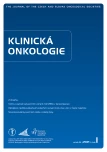Pretrvávajúca elevácia alfa-fetoproteínu u pacienta po liečbe nádoru semenníka
Authors:
Fedorkova Lucia; Ondrus Dalibor 1,2 1
Authors‘ workplace:
1st Department of Oncology, Comenius University, Faculty of Medicine & St. Elisabeth Cancer Institute, Bratislava, Slovakia
1; Department of Medical Oncology, St. Elisabeth Cancer Institute, Bratislava, Slovakia
2
Published in:
Klin Onkol 2021; 34(1): 56-58
Category:
Case Report
doi:
https://doi.org/10.48095/ccko202156
Overview
Východiská: Pretrvávanie zvýšenej hladiny alfa-fetoproteínu u pacienta s neseminómovým germinatívnym tumorom semenníka po orchiektómii a chemoterapii je výnimočný stav, kedy je potrebné odlíšiť pretrvávanie nádoru od falošnej pozitivity onkomarkera. Táto situácia často vedie k nadliečeniu pacienta, čo môže spôsobiť závažnú akútnu aj neskorú toxicitu a iné komplikácie spojené s liečbou.
Prípad: Prezentujeme prípad pacienta s vyššie uvedeným ochorením a priebehom liečby. Vzhľadom na to, že pretrvávanie ochorenia nebolo rádiologicky dokázané a hladina alfa-fetoproteínu bola mierne stabilne zvýšená, bol zvýšený onkomarker vyhodnotený ako falošne pozitívny. Možné príčiny zvýšenej hodnoty onkomarkera boli analyzované, keďže môže byť markerom aj iných závažných ochorení. Hladina alfa-fetoproteínu sa nezmenila ani pri abstinencii od alkoholu, ani pri podávaní hepatoprotektívnej liečby silymarínom. Sérológické testy hepatitíd B a C boli negatívne. Iný malígny tumor nebol identifikovaný. Na CT bolo nájdené zhrubnutie a stratifikácia cirkulárnej steny terminálneho ilea a reakcia okolitého viscerálneho tuku a lymfatických uzlín, ktoré pripomína nešpecifické zápaly čreva, ktoré by mohli vysvetľovať vyššiu hladinu alfa-fetoproteínu. Viac ako 14 mesiacov po ukončení liečby chemoterapiou pacient nemá žiaden dôkaz aktivity ochorenia, hladina alfa-fetoproteínu pretrváva nezmenená.
Záver: Ak nie je po ukončení liečby prítomný iný znak prítomnosti nádoru semenníka, ako zvýšený onkomarker, pacient by mal byť ďalej prísne observovaný.
Klíčová slova:
alfa-fetoproteín – onkomarkery – nádory semenníkov – chemoterapia
Sources
1. Bartlett NL, Freiha FS, Torti FM. Serum markers in germ cell neoplasms. Heamatol Oncol Clin North Am 1991; 5 (6): 1254–1260.
2. Talerman A, Haije WG, Baggerman L. Serum alphafe - toprotein (AFP) in patients with germ cell tumors of the gonads and extragonadal sites: correlation between endodermal sinus (yolk sac) tumor and raised serum AFP. Cancer 1980; 46 (2): 380–385. doi: 10.1002/1097-0142 (19800715) 46 : 2<380:: aid-cncr2820460228>3.0. co; 2-u.
3. Gilligan TD, Seidenfeld J, Basch EM et al. American Society of Clinical Oncology Clinical Practice Guideline on uses of serum tumor markers in adult males with germ cell tumors. J Clin Oncol 2010; 28 (20): 3388–3404. doi: 10.1200/JCO.2009.26.4481.
4. Albany C, Einhorn L. Pitfalls in management of patients with germ cell tumors and slight elevation of serum a-fetoprotein. J Clin Oncol 2014; 32 (19): 2114–2115. doi: 10.1200/JCO.2014.56.0607.
5. Schatte EC, Lerner SP. Re: Recognizing abnormal marker results that do not reflect disease in patients with germ cell tumors. J Urol 2000; 164 (5): 1670.
6. Wymer KM, Daneshmand S, Pierorazio PM et al. Mildly elevated serum alpha-fetoprotein (AFP) among patients with testicular cancer may not be associated with residual cancer or need for treatment. Ann Oncol 2017; 28 (4): 899–902. doi: 10.1093/annonc/mdx012.
7. Richie J, Steele G. Neoplasms of the testis. In: Wein AJ, Kavoussi LR, Novick AC, Partin AW, eds. Campbell–Walsh Urology. Philadelphia, PA: Saunders 2007: 907–908.
8. Germà–Lluch JR, Garcia del Muro X, Maroto P et al. Clinical pattern and therapeutic results achieved in 1490 patients with germ cell tumours of the testis: the experience of the Spanish Germ–Cell Cancer Group (GG). Eur Urol 2002; 42 (6): 553–563. doi: 10.1016/s0302-2838 (02) 00 439-6.
9. Schefer H, Mattmann S, Joss RA. Hereditary persistence of alpha-fetoprotein. Case report and review of the literature. Ann Oncol 1998; 9 (6): 667–672. doi: 10.1023/a: 1008243311122.
10. Thompson WG, Gillies RR, Silver HK et al. Carcinoembryonic antigen and alpha 1-fetoprotein in ulcerative colitis and regional enteritis. Can Med Assoc J 1974; 110 (7): 775–777.
11. Doherty AP, Bower M, Christmas TJ. The role of tumour markers in the diagnosis and treatment of testicular germ cell cancers. Br J Urol 1997; 79 (2): 247–252. doi: 10.1046/j.1464-410x.1997.27517.x.
12. Milose JC, Filson CP, Weizer AZ et al. Role of biochemical markers in testicular cancer: diagnosis, staging, and surveillance. Open Access J Urol 2012; 4 : 1–8. doi: 10.2147/OAJU.S15063.
13. Reilley MJ, Pagliaro LC. Testicular choriocarcinoma: a rare variant that requires a unique treatment approach. Curr Oncol Rep 2015; 17 (2): 2. doi: 10.1007/s11912-014-0430-0.
14. Oldenburg J, Fosså SD, Nuver J et al. Testicular seminoma and non-seminoma: ESMO Clinical Practice Guidelines for diagnosis, treatment and follow–up. Ann Oncol 2016; 24 (6): vi125–vi132. doi: 10.1093/annonc/mdt 304.
15. Gilligan T, Lin DW, Aggarwal R et al. Testicular Cancer, version 2.2020, NCCN Clinical Practice Guidelines in Oncology. J Natl Compr Canc Netw 2019; 17 (12): 1529–1554. doi: 10.6004/jnccn.2019.0058.
16. Laguna MP, Albers P, Albrecht W et al. EAU guidelines on testicular cancer; 2019. [online]. Available from: https: //uroweb.org/wp–content/uploads/EAU–Guidelines–on–Testicular–Cancer–2019–1.pdf.
17. Morris MJ, Bosl GJ. Recognizing abnormal marker results that do not reflect disease in patients with germ cell tumors. J Urol 2000; 163 (3): 796–801.
Labels
Paediatric clinical oncology Surgery Clinical oncologyArticle was published in
Clinical Oncology

2021 Issue 1
Most read in this issue
- Rehabilitácia pri rakovine prsníka
- Zárodečné mutace v genech RAD51C a RAD51D a dědičná predispozice ke vzniku karcinomu ovaria
- Droplet digitálna PCR ako nový diagnostický nástroj
- Skvamocelulárny karcinóm rekta u mladej ženy
